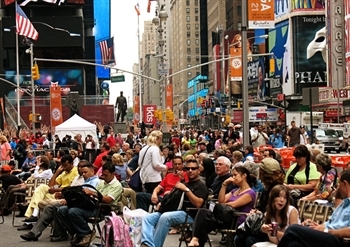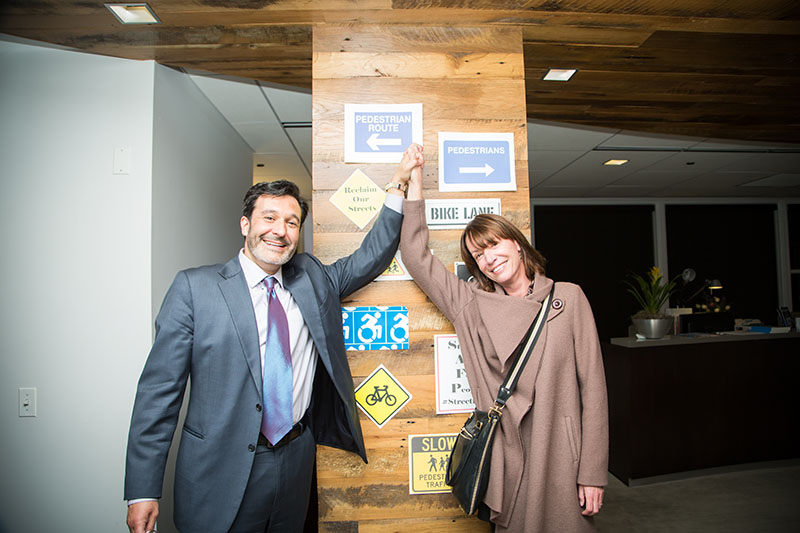
Photo by Tricia Scully
Janette Sadik-Khan energized MPC's Urban Think & Drink audience with tales of sticking to her guns as New York City's transportation commissioner.
Controversies always seem to emerge in news headlines, social media and dinner conversations when proposals are made to build bike lanes, dedicate more space to the public, change a few parking spots into people spots, or invest in faster transit. Chicago—being the fairly car-centric city that it is—has especially suffered from ongoing rows. Some groups always seem to have excuses for why changing the way they use their streets is impossible.
Janette Sadik-Khan, former NYC Transportation Commissioner under Mayor Bloomberg and co-author of a new book called Streetfight, encourages us to stand strong for policies and projects that make our streets better for everyone. At Metropolitan Planning Council’s (MPC) March 29 Urban Think & Drink, she emboldened 120 Chicago residents, transportation officials, advocates and policy wonks to remember that when there is backlash, it probably means you are doing something right.

Flickr user Meg Lessard (CC)
People flocked to the newly pedestrianized Times Square with beach chairs to enjoy the space.
During her time as New York City Transportation Commissioner (2007-2013), Sadik-Khan didn’t let excuses, naysayers, or even lawsuits hold back progress. She dared—during an election year—to close Times Square to cars, where people made up 90 percent of the traffic but had 10 percent of the space.
The result? No one said anything about “carmageddon.” Instead, people flocked to Times Square with their beach chairs, designating it the “living room of New York.”
Sadik-Khan noted that streets can be lively for people, but they’ve become a place for cars—by design, not accident. Engineers see fast cars moving unimpeded and celebrate a job well done. To combat this in NYC, she installed one of the world’s largest bike lane systems and bike sharing programs and led the construction of more than 60 plazas throughout the city that reclaimed underutilized spaces.
Of course there was opposition, but she hit the pavement to engage community members and advocacy groups to reimagine the city’s streets for all people… if they dared. And many did! Retail sales increased 50 percent on some streets where protected bike lanes were installed. That’s because, as Sadik-Khan says, “cars don’t shop, people do.”
The economic boost that good street design contributed to neighborhoods helped turn enemies into allies. When new NYC Mayor de Blasio thought of rolling back some of the pedestrian plaza policies, public outcry heralded that people-focused streets were there to stay in NYC.
As Sadik-Khan says, "Cars don't shop, people do."
So what can Chicago learn from Sadik-Khan’s Streetfight? She offered MPC’s Think & Drink audience some hints about the path forward for Chicago, where nearly 36.6 percent of daily commutes in the city involve public transportation, bicycles or walking.
DATA
Advocates and policymakers in Chicago should use data to change the conversation from anecdotes (drivers and cabbies complaining about how slow traffic will be based on their perception, etc.) to facts that demonstrate how changes to our streets can have measurable, quantifiable results. Chicago officials and advocates can make progress by collecting and amplifying data on pedestrians and cyclists and analyzing how traffic and taxi cabs actually move through the city.
FOLLOW THE PEOPLE
Sadik-Khan suggested that we look at where people are walking. She stated that “by looking at where people walk today, you can build your city for tomorrow.” Are pedestrians naturally jaywalking in the middle of a particular block? Why not install a large cross-walk between intersections? And how about crowdsourcing the location of people plazas and Divvy bike stations by having city residents submit particular spots for consideration?
"The public domain is the public's domain."
City planners and transportation officials should take the extra step to invest in creative designs for projects that use things like light, color and music to create positive environments. We have extensive road signs for drivers, why not wayfinding for pedestrians too?
BUILD RELATIONSHIPS
Because, as she boldly stated, “The public domain is the public’s domain.” Building relationships with the public can be just as important as building infrastructure. People all over Chicago are doing the hard work necessary to bring about positive change. Together we can aggregate ideas and adopt new designs for Chicago’s streets, reclaiming them for everyone.
These insights and more are detailed in Sadik-Khan’s book Streetfight, which highlights stories about pushing the envelope in New York and offers ideas that just might work here. As Sadik-Khan stated, “no one has a patent on pavement.” When you see a good idea working somewhere else, take it to your city and use it.
Chicago currently has more than 200 miles of on-street protected, buffered and shared bike lanes and the Divvy bike-share program continues to expand. The City has called for a 645-mile network by 2020. The Make Way for People program has overseen the installation and activation of people spots, people streets, people plazas and people alleys throughout the city. These are great initiatives pointing Chicago in the right direction, but they haven’t lacked controversy.
It’s always going to be challenging to promote safer streets for everyone. Together we can stand our ground and win our own ”streetfight” here in Chicago.

Photo by Tricia Scully
MPC Executive Vice President Peter Skosey celebrates a successful event with Janette Sadik-Khan.